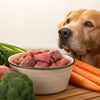How to Prepare Frozen Raw Dog Food for Optimal Nutrition
- Houndsy
Table of Contents
- Introduction
- Understanding Frozen Raw Dog Food
- Preparing Frozen Raw Dog Food Safely
- Portion Sizes for Frozen Raw Dog Food
- Transitioning Your Dog to Frozen Raw Food
- Storing Frozen Raw Dog Food
- Feeding Tips for Raw Dog Food
- Conclusion
Introduction
Did you know that pet owners are increasingly acknowledging the remarkable benefits of a raw dog food diet? Statistics indicate that nearly 40% of dog owners are now leaning towards feeding their pets raw food as a healthier alternative to conventional kibble. If you're considering this transition, you're in the right place! Today, we will delve into the intricacies of how to prepare frozen raw dog food, ensuring your furry friend receives the best natural nutrition, while also providing a smoother feeding experience for you.
The shift to raw dog food can significantly enhance your dog's well-being, addressing issues like allergies, digestive problems, and overall energy levels. This blog will serve as a comprehensive guide, equipping you with the knowledge needed to seamlessly add frozen raw dog food to your pet's regimen. We will cover everything from safe thawing methods to portion sizing, as well as essential tips for an easy transition.
As dog lovers ourselves, we encourage you to reflect on your feeding routines and consider how a raw diet might benefit your furry friend. Our mission at Houndsy is to simplify pet care experiences, and we truly believe that making informed choices about your dog's diet is a vital piece of that puzzle.
Key Takeaways
By the end of this post, you'll have a solid understanding of:
- The advantages of feeding raw dog food.
- Safe methods for thawing and preparing frozen raw dog food.
- Tips for transitioning your dog to a raw diet.
- Best practices for portion control and handling.
You’ll be ready to enrich your pup's dining experience in a way that makes both your lives more enjoyable, paving the way for a happier, healthier canine companion.
Understanding Frozen Raw Dog Food
The Benefits of Feeding Raw
Transitioning to frozen raw dog food can bring a wealth of benefits to your pet's health. Raw diets usually consist of high-quality meat, bones, fruits, and vegetables, offering a biologically appropriate diet that mirrors what dogs would eat in the wild. Some of the notable advantages include:
- Enhanced Digestion: Raw food is less processed than commercial kibble, allowing for easier digestion and nutrient absorption.
- Improved Coat Condition: A raw diet often leads to a shinier coat, healthier skin, and reduction in allergic reactions.
- Increased Energy Levels: Many pet owners report that their dogs exhibit higher energy levels and better overall vitality after transitioning to raw food.
However, the preparation and handling of raw food require diligence and care. We want to ensure you and your pet can reap the full benefits without compromising safety.
Preparing Frozen Raw Dog Food Safely
Safe Thawing Techniques
Effective thawing is crucial for maintaining the safety and quality of the food. Here are several appropriate methods for thawing frozen raw dog food:
-
Refrigerator Method:
- Place the required amount of frozen raw food in the refrigerator for 24-36 hours prior to feeding. This method keeps the food at a safe temperature, inhibiting bacteria growth. It’s the recommended way to ensure safety and nutrient retention.
-
Cold Water Method:
- If you're in a hurry, submerge the sealed package of raw food in cold water. This method will thaw your food more quickly while keeping it below 70°F, which prevents bacterial growth. Be sure to change the water every 30 minutes to maintain a consistent temperature.
-
Countertop Method:
- For smaller portions, you can leave the food on the counter for a brief period of 10-20 minutes to thaw, but this is less preferable. Make sure to monitor it closely to prevent it from entering the “danger zone” of 40°F to 140°F, where bacteria can multiply.
What Not to Do
It’s essential to be aware of methods that should be avoided when thawing raw dog food:
- Microwave: This can unevenly cook the food, creating hot spots that destroy beneficial enzymes and nutrients, as well as making bones excessively brittle.
- Boiling Water: Similar to the microwave, this method kills vital nutrients and may also compromise the food's safety.
- Leaving Out at Room Temperature: This practice can lead to bacterial contamination, so it should always be circumvented.
Importance of Cleanliness
Before and after handling raw dog food, always wash your hands thoroughly and sanitize any surfaces or utensils that come into contact with the food. This practice minimizes the risk of cross-contamination and keeps both you and your pet safe.
Portion Sizes for Frozen Raw Dog Food
How Much Should I Feed?
Determining the right portion for your dog can depend on several factors, including their size, age, activity level, and overall health. We recommend consulting your veterinarian for guidance tailored to your dog’s specific needs. That being said, a general rule of thumb is as follows:
- Small Dogs (up to 20 lbs): 1/4 to 1/2 cup per meal.
- Medium Dogs (20-50 lbs): 1/2 to 1 cup per meal.
- Large Dogs (50-100 lbs): 1 to 2 cups per meal.
- Extra Large Dogs (over 100 lbs): 2 to 3 cups per meal.
This can vary based on calorie needs, and it’s beneficial to monitor your dog’s weight and energy levels, adjusting their portions accordingly.
Helpful Tips for Portion Control
- Invest in a Measuring Cup: This will help you serve consistent portions each time, reducing the risk of overfeeding or underfeeding.
- Use a Food Dispenser: Products like the Houndsy Kibble Dispenser allow for easy measuring and storage, ensuring that feeding time is smooth and efficient.
- Transition Gradually: If your dog is switching from traditional kibble to raw food, we recommend starting with a small percentage of raw mixed with their current food, gradually increasing the raw portion over time.
Transitioning Your Dog to Frozen Raw Food
Transforming your dog’s diet shouldn’t be rushed. A gradual transition helps to avoid potential digestive upset. Follow this plan:
-
Start Slow: For the first 7-10 days, consider mixing about 25% raw food with 75% of their regular diet. Gradually increase the ratio of raw food over this period, aiming for a full transition by the end of it.
-
Observe and Adjust: Monitor your dog closely for any signs of digestive disturbances, such as diarrhea or vomiting. If issues occur, slow the transition down and spend more time at each step.
-
Add Probiotics: Enhancing their digestive health with probiotics, like plain yogurt or specific pet-safe supplements, can also facilitate a smoother transition.
Storing Frozen Raw Dog Food
Freezer Storage Tips
To maintain the nutrient integrity and flavor of frozen raw dog food, proper storage is essential:
- Keep it Sealed: Ensure that raw dog food remains in its packaging or an airtight container while stored in the freezer to prevent freezer burn and contamination.
- Label Packages: If you’ve divided portions, label them with the contents and date to keep track of how long it has been stored.
- Thaw Wisely: Once thawed, remember that raw food should not be refrozen. Use it within 1-2 days after thawing to ensure safety and quality.
Fridge Storage After Thawing
Thawed raw dog food can be kept in the refrigerator for up to two days if stored correctly. Factor in your dog's consumption, as this ensures they receive fresh food without the risk of spoilage.
Feeding Tips for Raw Dog Food
Water and Hydration
Always provide fresh water alongside meals, as hydration is essential for your dog's overall health, particularly when switching to a raw diet. You may also consider adding low-sodium broth or water directly into the food to enhance moisture content and palatability.
Satisfying Your Dog's Taste Preferences
Most dogs tend to gravitate towards a variety of protein sources. If your pup is reluctant to eat frozen raw food at first, consider adding chicken broth or incorporating small amounts of their favorite kibble to entice them.
Conclusion
In summary, transitioning to frozen raw dog food can be a transformative experience for your pet, ushering in numerous health benefits while also requiring careful planning and execution by you, the loving pet owner. By understanding how to prepare frozen raw dog food, you set the stage for a happier, healthier dog and a more enjoyable feeding ritual.
As a final thought, we encourage you to reflect on how this shift could enhance your bonding experience with your furry family member. Evaluating your dog’s diet is an essential step toward optimal health, and at Houndsy, we support you in every aspect of pet care, including our innovative solutions like the Houndsy Kibble Dispenser for easy measurement and stylish storage.
FAQ
Is frozen raw dog food safe for my pet?
Yes, as long as you follow safe handling guidelines. Always prepare and store raw food properly to minimize the risk of bacterial contamination.
How long can frozen raw dog food be stored?
Unopened frozen raw dog food can be kept in the freezer for up to 12 months. Once opened, it should be consumed within four months.
Can I mix frozen raw dog food with dry kibble?
Yes, you can combine raw food with kibble, but be sure to monitor your dog's reaction and adjust accordingly as they adapt to the new diet.
How often should I feed my dog raw food?
Dogs are generally fed raw food 1-2 times per day based on their size and dietary needs. Consult your veterinarian for personalized recommendations.
What if my dog refuses to eat raw food?
If your dog is hesitant to transition, start by mixing small amounts of raw food with their regular kibble. Gradually increase the proportion of raw as they adjust to the new taste and texture.












